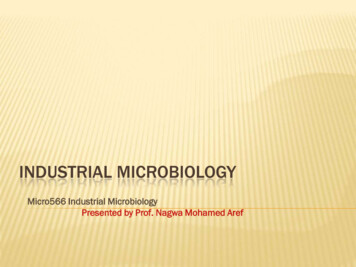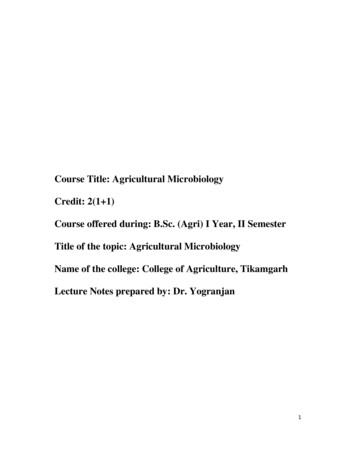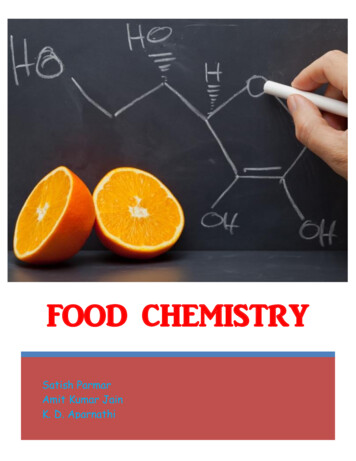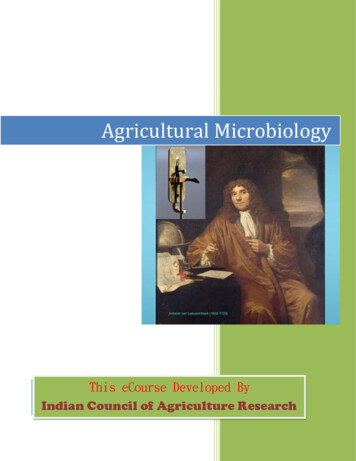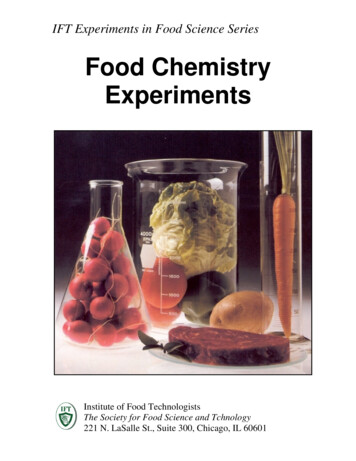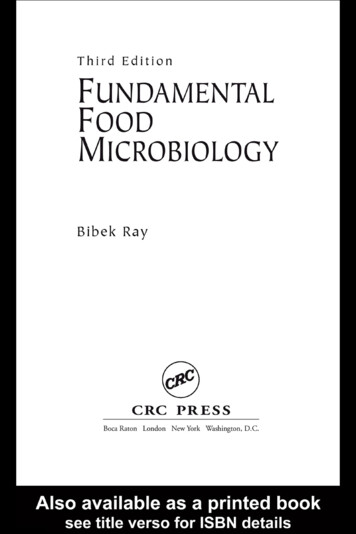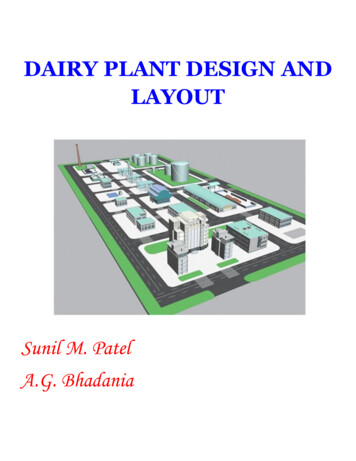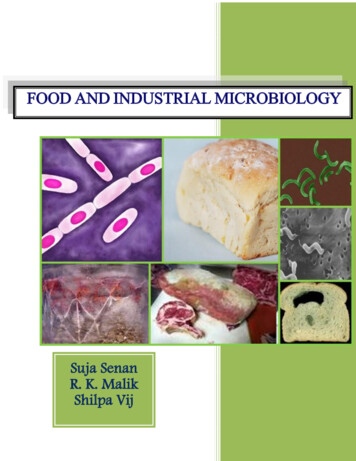
Transcription
FOOD AND INDUSTRIAL MICROBIOLOGYSuja SenanR. K. MalikShilpa Vij
Food and Industrial MicrobiologySuja SenanDepartment of Dairy Microbiology & BiotechnologyAAU, AnandR. K. Malik & ShilpaVijDairy Microbiology DivisionNDRI, KarnalThis Book Download From e-course of ICARConverted By:
Course OutlineLesson NamePage NoModule 1: The Trajectory of Food MicrobiologyLesson 1. Introduction to Food Microbiology - Part I:Bacteria1-13Lesson 2. Introduction to Food Microbiology - Part II: Yeast, Mold and Virus14-16Module 2: Microorganisms and Food MaterialsLesson 3. Microbial growth and its Quantification17-22Lesson 4. Factors affecting growth and survival of microorganisms in Foods23-31Lesson 5. Role of Predictive Microbiology32-34Module 3: Microbiology of Food CommoditiesLesson 6. Overview of Spoilage35-39Lesson 7. Microbial spoilage of Fruits and Fruit juices40-45Lesson 8. Microbial spoilage of Vegetables46-51Lesson 9. Microbial spoilage of Cereals and Bakery Foods52-55Lesson 10. Microbiology of Meat, Poultry, Sea foods56-61Lesson 11. Microbial spoilage of Canned Foods62-65Module 4 : Microbiology of Food PreservationLesson 12. Physical methods-Thermal Processing66-74Lesson 13. Physical methods: Part II: Non Thermal Processing75-79Lesson 14. Chemical Methods80-82Lesson 15. Natural Antimicrobial Compounds83-86Lesson 16. Emergency Methods of Food Preservation87-91Lesson 17. Combination Methods of Preservation92-94
Lesson 18. Biotechnology in Food Preservation95-100Module 5 : BioprocessingLesson 19. Overview of Bioprocessing101-111Lesson 20. Growth Curve, Growth Measurement, Growth Cultivation112-121Lesson 21. Growth Cultivation-Batch and Continuous Type122-127Module 6 : Fermentation Process StrategiesLesson 22. Types of Fermentation-Submerged, Solid and Surface Type128-134Module 7 : Bioreactor configurationLesson 23. Fermentors: Types, Functions, Design and Control135-141Lesson 24. Submerged Fermentor System and Their Types142-145Lesson 25. Solid Fermentor System and Their Types146-149Module 8 : Stages in a fermentation processLesson 26. Upstream Processing and Downstream Processing150-158Module 9 : Microbial Process StrategiesLesson 27. Single Cell Protein and Industrial Alcohol159-165Lesson 28. Organic Food-Citric, lactic and Vinegar166-172Lesson 29. Industrial Enzymes and Vitamin B-12173-176Lesson 30. Bacteriocins and Antibiotics177-179Lesson 31. Fermented Foods180-186Module 10 : Dairy Waste managementLesson 32. Treatment and Disposal of Waste Water and Effluents187-192
www.AgriMoon.Com FOOD AND INDUSTRIAL MICROBIOLOGYModule 1. The Trajectory of Food MicrobiologyLesson 1Introduction to Food Microbiology: Part-I: Bacteria1.1 IntroductionFood science is a discipline concerned with all aspects of food - beginning after harvesting, and ending withconsumption by the consumer. It is considered one of the agricultural sciences, and it is a field which is entirelydistinct from the field of nutrition. The field of food microbiology is a very broad one, encompassing the studyof microorganisms which have both beneficial and deleterious effects on the quality and safety of raw andprocessed foods. It is important to understand the relationships among the various microorganisms making upthe microflora of a food. Infact food microbiologists are concerned with the practical implications of themicroflora of the food and the food microorganisms that can cause spoilage of food and disease in humans. Theprimary tool of microbiologists is the ability to identify and quantitate food-borne microorganisms. However,the inherent inaccuracies in enumeration processes, and the natural variation found in all bacterial populationscomplicate the microbiologist‘s job. Moreover, they may be important from the aesthetic point of view. Ofcourse, some useful bacteria may be important because they change the functional properties of food stuffsresulting in new tastes, odors or textures. Microorganisms in food include bacteria, molds, yeasts, algae, viruses,parasitic worms and protozoa. These organisms differ in size and shape and in their biochemical and culturalcharacteristics.The microorganisms described below are among the most important genera and species normally found in foodproducts. Each microorganism has its own particular nutritional and environmental requirements.1.2 Bacteria1.2.1 AcinetobacterAcinetobacter is a genus of Gram-negative bacteria belonging to the Gammaproteobacteria. Acinetobacter species are non-motile and oxidase-negative, and occur in pairs as observed undermagnification. Young cultures show rod shaped morphology. They are strict aerobes that do not reduce nitrates.They are important soil and water organisms and are also found on many foods especially refrigerated freshproducts. A. baumannii is a frequent cause of nosocomial pneumonia, especially of late onset ventilatorassociated pneumonia. It can cause various other infections including skin and wound infections, bacteremia,and meningitis,1.2.2 Bacillus cereusB. cereus is a thick long rod shaped Gram positive, catalase positive aerobic spore former and the organism isimportant in food borne illness. It is a normal inhabitant of soil and is isolated from a variety of foods. It is quiteoften a cause of diarrheal illness due to the consumption of desserts, meat, dishes, dairy products, rice, pasta etcthat are cooked and kept at room temperature as it is thermoduric. Some of the B. cereus strains arepsychrotrophic as they grow at refrigeration temperature.1
www.AgriMoon.Com FOOD AND INDUSTRIAL MICROBIOLOGYB. cereus is spread from soil and grass to cows udders and into the raw milk. It is also capable of establishing incans. It is also capable of producing proteolytic and amyloltic enzymes and also phoslipase C (lecithinase). Theproduction of these enzymes by these organisms can lead to the spoilage of foods. The diarrheal illness iscaused by an enterotoxin produced during the vegetative growth ofB. cereus in small intestine. The bacteriumhas a maximum growth temperature around 48 C to 50 C and pH range 4.9 to 9.3. Like other spores ofmesophilic Bacillus species, spores of B. cereus are also resistant to heat and survive pasteurizationtemperature.1.2.3 Bacillus subtilisBacillus subtilis , known also as the hay bacillus or grass bacillus , is a Gram-positive, catalase-positivebacterium commonly found in soil. A member of the genus Bacillus, B. subtilis is thin short rod-shaped, and hasthe ability to form a tough, protective endospore, allowing the organism to tolerate extreme environmentalconditions. B. subtilis produces the proteolytic enzyme subtilisin. B. subtilisspores can survive the extreme heatduring cooking. B. subtilis is responsible for causing ropiness a sticky, stringy consistency caused by bacterialproduction of long-chain polysaccharides in spoiled bread dough. A strain of B. subtilis formerly knownas Bacillus nattois used in the commercial production of the Japanese food natto, as well as the similar Koreanfood cheonggukjang. It is used to produce amylase and also used to produce hyaluronic acid, which is useful inthe joint-care sector in healthcare.1.2.4 CarnobacteriumCarnobacterium is a genus of Gram-positive bacteria within the family Leuconostocaceae. C. divergens and C.maltaromaticum are found in the wild and in food products and can grow anaerobically. These species are notknown to be pathogenic in humans but may cause disease in fish. The genus Carnobacterium contains ninespecies, but only C. divergens and C. maltaromaticum are frequently isolated from natural environments and2
www.AgriMoon.Com FOOD AND INDUSTRIAL MICROBIOLOGYfoods. They are tolerant to freezing/thawing and high pressure and able to grow at low temperatures,anaerobically. They metabolize arginine and various carbohydrates, including chitin, and this may improve theirsurvival in the environment. Carnobacterium divergens and C. maltaromaticum have been extensively studiedas protective cultures in order to inhibit growth of Listeria monocytogenes in fish and meat products. Severalcarnobacterial bacteriocins have been identified and described. Carnobacteria can spoil chilled foods, butspoilage activity shows intraspecies and interspecies variation. Their production of tyramine in foods is criticalfor susceptible individuals, but carnobacteria are not otherwise human pathogens.1.2.5 CorynebacteriumCorynebacterium is a genus of Gram-positive rod-shaped bacteria. They are widely distributed in nature and aremostly innocuous. Some are useful in industrial settings such as C. glutamicum. Others can cause humandisease. C. diphtheriae, for example, is the pathogen responsible for diphtheria. Some species are known fortheir pathogenic effects in humans and other animals. Perhaps the most notable one is C. diphtheriae, whichacquires the capacity to produce diphtheria toxin only after interacting with a bacteriophage. Diphtheria toxin isa single, 60,000 molecular weight protein composed of two peptide chains, fragment A and fragment B, heldtogether by a disulfide bond.1.2.6 Clostridium perfringensC. perfringens is a Gram-positive encapsulated anaerobic non-motile bacterium commonly found on meat andmeat products. It has the ability to cause food borne disease. It is a toxin producing organism-produces C.perfringens enterotoxin and β -toxin that are active on the human GI tract.It multiplies very rapidly in food (doubling time 10 min). Spores are resistant to radiation, desiccation andheat and thus survive in incompletely or inadequately cooked foods.However, it tolerates moderate exposure to air. Vegetative cells of C. perfringens are also somewhat heattolerant as they have relatively high growth temperature (43 C -45 C ) and can often grow at 50 C. They arenot tolerant to refrigeration and freezing. No growth occurs at 6 C . C. perfringens is present in soil and theother natural environment.1.2.7 Clostridium botulinumC. botulinum produces the most potent toxin known. It is a Gram-positive anaerobic rod shaped bacterium. Ovalendospores are formed in stationary phase cultures. There are seven types of C. botulinum (A to G) based on theserological specificity of the neurotoxin produced. Botulism is a rare but very serious disease. The ingestion ofneurotoxin produced by the organism in foods can lead to death. However, the toxin (a protein) is easilyinactivated by heat. The organism can grow at temperature ranging from 10-48 C with optimum growthtemperature at 37 C. Spores are highly heat resistant. The outgrowth of spores is inhibited at pH 4.6, NaCl 3
www.AgriMoon.Com FOOD AND INDUSTRIAL MICROBIOLOGY10% or water activity 0.94. Botulinum spores are probably the most radiation resistant spores of public healthconcern. Contamination of foods is through soil and sediments where they are commonly present. The organismgrows under obligate anaerobic conditions and produces toxin in under processed (improper canning) low acidfoods at ambient temperature.1.2.8 CampylobacterCampylobacter are Gram negative nonspore forming rods. Campyloleacter jejuni is an important food bornepathogen. It is one of the many species within the genus Campylobacter. Campylobacter species C.jejuni and C. coli cause diarrhea in humans. The organism is heat sensitive (destroyed by milk pasteurizationtemperature). It is also sensitive to freezing. The organism belongs to the family Campylobactereaceae. Theorganisms are curved, S-shaped, or spiral rods that may form spherical or coccoids forms in old cultures orcultures exposed to air for prolonged periods. Most of the species are microaerophilic. It is oxidase and catalasepositive and does not grow in the presence of 3.5% NaCl or at 25 C or below. The incidences reported forgastro enteritis by this organism are as high as in case of Salmonella.The organism is commonly present in raw milk, poultry products, fresh meats, pork sausages and ground beef.The infective dose of C.jejuni may be 1,000 organisms.1.2.9 ErwiniaErwinia is a genus of the family Enterobacteriaceae bacteria containing mostly plant pathogenic species. Theorganisms was named after the first phytobacteriologist, Erwin Smith. It is a Gram negative bacterium relatedto E. coli, Shigella, Salmonella and Yersinia. It is primarily a rod-shaped bacterium. A well-known member ofthis genus is the species E. amylovora, which causes fire blight on apple, pear and other Rosaceouscrops. Erwinia carotovora (also known as Pectobacterium carotovorum) is another species, which causesdiseases in many plants. These species produce pectolytic enzymes that hydrolyze pectin between individualplant cells. . Decay caused by E. carotovora is often referred to as bacterial soft rot (BSR). Most plants or plantparts can resist invasion by the bacteria, unless some type of wound is present. High humidity and temperaturesaround 30 C favor development of decay.4
www.AgriMoon.Com FOOD AND INDUSTRIAL MICROBIOLOGY1.2.10 Enterococcus (E. faecium, E. faecalis )Enterococcus is a genus of lactic acid bacteria. Enterococci are Gram positive cocci that often occur in pairs(diplococci) or short chains and are difficult to distinguish from streptococci on physical characters mentionedabove. The two species are commensal organisms in the intestine of humans.The Enterococci are facultative anaerobic organisms non spore forming that grows optimally at 35 C .However, they tolerate wide range of environmental conditions (10-45 C) pH (4.5 to 10.5) quite high NaClconcentration (.6.5%) and can survive heating at 60 C for 30 min.Catalase-negative, oxidase negative-bacteria of the genes Enterococcus are ubiquitous organisms that oftenoccur in large numbers on vegetables, plant materials and foods especially those of animal origin such as meatand dairy products. Enterococci also constitute a large preparation of autochthonous bacteria associated with themammalian gastro-intestinal tract.The resistance of enterococci to pasteurization temperatures and their adaptability to different substrates andgrowth conditions in food products manufactured from raw materials and in heat treated food products is ofgreat significance.Enterococci may constitute an important part of the microflora of fermented cheese and meats.1.2.11 Escherichia coliE. coli strains are associated with food borne gastroenteritis. These are Gram-negative asprogeneous rods thatferment lactose and produce dark colonies with a metallic sheen on Endo agar. The organism grows well on alarge number of media and in many foods. They grow over a wide range of temperature (4 to 46 C ) and pH(4.4 to 9.0).However, they grow very slowly in foods held at refrigerator temp. (5 C ). They belong to thefamily Enterobacteriaceae. The organism is also an indicator of fecal pollution. The organism is also capable ofproducing acid and gas and off-flavours in foods. E. coli strains involved in foodborne-illness can be placed intofive groups: enteropathogenic (EPEC), enterotoxigenic (ETEC), enteroinvasive (EIEC), enterohemorrhagic(EHEC) and facultatively enteropathogenic (FEEC).The organism also grows in the presence of bile salts. The primary habitat of E.coli is the intestinal tract of mostwarm blooded animals. E.coli 0157: H7 strains are unusually tolerant of acidic environments.5
www.AgriMoon.Com FOOD AND INDUSTRIAL MICROBIOLOGY1.2.12 LactococcusL.lactis subsp. lactisL.lactis subsp. cremorisL.lactis subsp.lactis biovar diaectylactisLactococcus is a genus of lactic acid bacteria that were formerly included in the genus Streptococcus Group N(Group N Streptococci). They are known as homofermentors meaning that they produce a single product ofglucose fermentation. They are Gram-positive, catalase negative, non-motile coccus that are found singly, inpairs or in chains. Some of the strains of lactococci are known to grow at or below 7 C.Lactococci are intimately associated with dairy products. These organisms are commonly used in the dairyindustry in the manufacture of fermented dairy products like cheeses. They can be used in single strain startercultures or in mixed strain cultures with other lactic acid bacteria such as Lactobacillus and Streptococcus.Their main purpose in dairy production is the rapid acidification of milk. This causes drop in the pH offermented product which prevents the growth of spoilage and pathogenic bacteria. These bacteria also play arole in the flavor of the final product. Dairy lactococci have also been exploited for several industrialfermentations in the biotechnology industry. They are easily grown at industrial scale up on cheap whey basedmedia.Lactococcus lactis subsp. lactis includes species formerly designated as S. lactis subsp. lactis. L.lactis subsp. cremoris is distinguished from L. Lactis subsp. lactis by the inability to (i) grow at 40 C (ii) growin 4% NaCl (iii) hydrolyse arginine and (iv) ferment ribose.1.2.13 Lactobacillus (L. bulgaricus, L. helveticus. L. plantarum,L. acidophilus, L. casei, L. lactis, L. fermentum)6
www.AgriMoon.Com FOOD AND INDUSTRIAL MICROBIOLOGYThe organisms belonging to this important genus are rods usually long and slender and in some of the speciesform chains. They are aerotolerant/microaerophilic but some ferment sugars chiefly to lactic acids if they arehomofermentative. The hetero fermentative species, besides lactic acid, also produce small amount of aceticacid, carbon dioxide and trace amounts of volatile compounds such acetaldehyde and alcohol. Thehomofermentative species of Lactobacillus include L. bulgaricus, L. casei, L. helveticus, L. lactis, L.acidophilus and grow optimally at 37 C. L. fermentum, L. brevis are the typical example of heterofermentative Lactobacillus and grow well at higher temperatures.Lactobacilli are of considerable importance in foods as they ferment sugar to lactic acid and other desirableflavouring compounds and are thus used in the production of fermented plant dairy and meat products.However, they are also implicated in the spoilage of wine and beer.The organism normally occurs on plant surfaces silage, manure and dairy products. They are quite fastidious intheir nutritional requirements as they are unable to synthesize certain vitamins they require and, therefore,media need to be supplemented with these vitamins for their growth.Some of the strains are psychotrophic in nature and are thus involved in the spoilage of refrigerated meats. Onthe other hand thermoduric properties (resistance to pasteurization temperature) of some of the thermophilicstrains of lactobacilli are quite useful in the manufacture of certain varieties of cheeses e.g. Swiss cheese. Somestrains of lactobacilli also show probiotic attributes and are finding application in functional probiotic foods andin pharmaceutical preparations.1.2.14 LeuconostocLeuconostoc is a genus of Gram-positive bacteria, placed within the family of Leuconostocaceae. They aregenerally ovoid cocci often forming chains. Leuconostoc spp. are intrinsically resistant to vancomycin and arecatalase-negative (which distinguishes them from staphylococci). All species within this genus areheterofermentative and are able to produce dextran from sucrose. They are generally slime-forming. Blamed forcausing the 'stink' when creating a sourdough starter, some species are also capable of causing human infection.Leuconostoc spp. along with other lactic acid bacteria such as Pediococcus and Lactobacillus spp , isresponsible for the fermentation of cabbage, to sauerkraut. In this process the sugars in fresh cabbage aretransformed to lactic acid which give it a sour flavour and good keeping qualities.1.2.15 Listeria monocytogenesListeria monocytogenes in foods has attracted worldwide attention due to the serious illness it causes in humanbeings. The Listeria are Gram positive non spore forming, nonacid-fast rods. The organism is catalase positiveand produces lactic acid from glucose and other fermentable sugars. The organism grows well in brain heartinfusion (BHI), trypticase soy, and tryptose broths. However, the medium should be fortified with B. vitaminsand the amino acids. It is a mesophilic organism with optimal growth temperature 37 C but it can grow atrefrigerator temperature also. Strains grows over the temperature range of 1 C to 45 C and pH range 4.1 to 9.6.7
www.AgriMoon.Com FOOD AND INDUSTRIAL MICROBIOLOGYListeria monocytogenes is widely distributed in nature and can be isolated from decaying vegetation, soil,animal feces, sewage, silage and water. The organism has been found in raw milk, pork, raw poultry, groundbeef and vegetables. The HTST treatment of pasteurization is good enough to destroy the organism in milk.The most significant virulence factor associated with L. monocytogenes is listeriolysin O. The virulent strainsproduce β-hemolysis on blood agar and acid from rhamnose.L. monocytogenes grows well in moderate salt concentrations (6.5%).L. monocytogenes is unique among foodborne pathogens while other pathogens excrete toxins or multiply in theblood stream, L. monocytogenes enters the host‘s cells and grows inside the cell. In humans it crosses theintestinal barrier after entering by the oral route.Ready to Eat (RTE) foods that are preserved by refrigeration pose a special challenge with regard to L.monocytogenes infection.1.2.16 MicrococcusMicrococcus occurs in a wide range of environments, including water, dust, and soil. Micrococci are Grampositive spherical cells ranging from about 0.5 to 3 micrometers in diameter and typically appear intetrads. Micrococcus has a substantial cell wall, which may comprise as much as 50% of the cell mass. Somespecies of Micrococcus, such as M. luteusM. roseus (red) produce yellow or pink colonies when grown onmannitol salt agar. Micrococcus is generally thought to be a saprophytic or commensal organism, though it canbe an opportunistic pathogen, particularly in hosts with compromised immune systems, such as HIV patients.1.2.17 ProteusSince it belongs to the family of Enterobacteriaceae, general characters are applied on this genus: It is oxidasenegative, but catalase and nitrate reductase positive. Three species P. vulgaris, P. mirabilis, and P. penneri areopportunistic human pathogens. Proteusincludes pathogens responsible for many human urinary tractinfections. P. mirabilis causes wound and urinary tract infections. Most strains of P. mirabilis are sensitive toampicillin and cephalosporins. P. vulgaris is not sensitive to these antibiotics. However, this organism isisolated less often in the laboratory and usually only targets immune suppressed individuals. P. vulgaris occursnaturally in the intestines of humans and a wide variety of animals; also manure, soil and polluted waters. P.mirabilis, once attached to urinary tract, infects the kidney more commonly than E. coli. P. mirabilis are oftenfound as free-living organisms in soil and water.1.2.18 Propionibacterium spp. (P. freudenreichii)Historically, Propionibacterium spp. are of interest because of their use as dairy starters (especially in theproduction of Swiss-type cheese) and their ability to produce propionic acid during growth. Thegenus Propionibacterium roups.The8
www.AgriMoon.Com FOOD AND INDUSTRIAL MICROBIOLOGYdairy Propionibacterium spp. can also be isolated primarily from dairy foods and silage. The species in dairyproducts include P. jensenii, P. acidipropionici, P. theoniiP. freudenreichii. Propionibacteria have a role in theproduction of flavour compounds in cheese by proteolysis and propionic acid production. Dairy strains ofpropionibacteria are autolytic under environmental conditions found in cheese and degrade peptides and aminoacids that are present in the cheese. And The dairy species offer an interesting opportunity as novel probioticorganisms with the most obvious advantage being that they are considered safe for ingestion.1.2.19 Pediococcus spp. (Pediococcus pentosaceus, P. acidilactici)Pediococci compromise a group of bacteria that are of economic importance in the brewing and food industries.Several species and strains of pediococci have been used as starter cultures in the fermentation of vegetables,meats, sausage products, fermented milks and associated with the development of flavor in Cheddar and otherrelated cheese varieties. Some strains form capsular material that causes beer to become ropy and viscous.They are catalase negative and exhibit a homolactic type of fermentation and produce optically inactive lacticacid i.e. a mixture of the L( ) and D(-) type. They generally appear in tetrads.1.2.20 Pseudomonas fluorescensPseudomonas fluorescens is a common Gram-negative, rod-shaped, motile bacterium. The organism ispsychrotrophic in nature and grows at refrigeration temperature (7 C). It has an extremely versatile metabolism,and can be found in the soil and in water. It is an obligate aerobe, but certain strains are capable of using nitrateinstead of oxygen as a final electron acceptor during cellular respiration. Optimal temperature for growthof Pseudomonas fluorescens is 25-30 C. It tests positive for the oxidase. Pseudomonas fluorescensis also anonsaccharolytic organism. Heat-stable lipases and proteases are produced by Pseudomonas fluorescens andother similar pseudomonads. These enzymes cause milk to spoil, by causing bitterness, casein breakdown, andropiness due to the production of slime and coagulation of proteins.1.2.21 Pseudomans aeruginosaIt is a Gram-negative, aerobic, rod-shaped bacterium with unipolar motility. An opportunistic humanpathogen, P. aeruginosa is also an opportunistic pathogen of plants. P. aeruginosa is the type species of thegenus Pseudomonas (Migula). Gram-stainedPseudomonas aeruginosa bacteria (pink-red rods) secretes avariety of pigments, including pyocyanin (blue-green), pyoverdine (yellow-green and fluorescent), and9
www.AgriMoon.Com FOOD AND INDUSTRIAL MICROBIOLOGYpyorubin (red-brown). P. aeruginosa is often preliminarily identified by its fluroscence and grape-like ortortilla-like odor in vitro. Definitive clinical identification of P. aeruginosa often includes identifying theproduction of pyocyanin and fluorescein, as well as its ability to grow at 42 C. P. aeruginosa is capable ofgrowth in diesel and jet fuel, where it is known as a hydrocarbon-using microorganism (or "HUM bug"),causing microbial corrosion. P. aeruginosa is considered by many as a facultative anaerobe1.2.22 Salmonella (S. typhimurium, S. typhi, S.enteritidis)Salmonella spp. have been reported to be a leading cause of foodborne illnesses in humans. Foodbornesalmonellosis scores over all other foodborne bacterial illnesses in humans. Enteric fever is a serious humandisease associated with typhoid and paratyphoid strains. SalmonellaEnterobacteriaceae. The optimum growthtemperature is 37-45 C. The organism can also grow at about 7 C in foods. I t ferments carbohydrates with itsproduction of acid and gas. Salmonella are oxidase negative, catalase positive and grow on citrate as a solecarbon source and produce H2S. Some Salmonella strains can grow at higher temperatures (54 C) while othersexhibit psychrotrophic properties. The organism has the ability to grow at pH values ranging from 4.5 to 9.5,with an optimum pH growth at 6.5 to 7.5. spp. are facultatively anaerobic, small Gram-negative, non sporeforming, rod-shaped (2-4 m m) bacteria belonging to the familyMilk, meat and poultry are principle vehicles of human foodborne salmonellosis. Ingestion of only a fewsalmonella cells can be infectious. Low levels of salmonellae in a finished food products may, therefore, be ofserious public health consequence.1.2.23 SerratiaSerratia is a genus of Gram-negative,facultatively anaerobic, rod-shaped bacteria ofthe Enterobacteriaceae family. The most common species in the genus, S. marcescens, is normally the onlypathogen and usually causes nosocomial infections. However, rare strains of S. plymuthica, S. liquefaciens, S.rubidaea, and S. odoriferae have caused diseases through infection. Members of this genus producecharacteristic red pigment, prodigiosin.10
www.AgriMoon.Com FOOD AND INDUSTRIAL MICROBIOLOGY1.2.24 Streptococcus thermophilusThe only streptococcus species that is associated with food technology is S. thermophilus which is used in themanufacture of yoghurt (in co culture with L. bulgaricus and Dahi).S. thermophilus is a Gram positive facultative anaerobe and belongs to the family Streptococcaceae. It iscatalase negative organism that is non-motile, non-spore forming and homofermentative and occurs in pairs tolong chains. The spherical to avoid cells are with a diameter in the range of 0.7 to 0.9 µm. The optimumtemperature for the growth of this organism is between 39 C to 45 C, although most species in the genus areable to grow at temperature ranging from 45-60 C. They do not grow at temperature below 20 C, but they cansurvive at 65 for 30 min. They ferment sugars with L ( ) lactic acid as the major end product and producearound 0.6 to 0.8% lactic acid. They are able to grow in broth with 2.5% NaCl but fail to grow in 6.5% NaCl atpH 9.6 or in milk with 0.1% methylene blue (Bergey‘s Manual 1994). It is also classified as lactic acid bacteria(LAB). It is a very versatile organism. S. thermophilus has properties that make it one of the commercially mostimportant lactic acid organism. S. thermophilus is used along with Lactobacillus spp., as a starter culture tomanufacture several important fermented dairy foods including yoghurt and mozzarella cheese.Though the natural habitat of S. thermophilus is yet to be established, most strains have been isolated from milkenvironments.1.2.25 Staphylococcus aureusStaphylococcus aureus is commonly associated with humans. It is a Gram-positive catalase-positivecoccus. Staphylococcus aureus is the common cause of foodborne gastroenteritis known as staphylococcal foodpoisoning. Staphylococcal gastroenteritis is caused by the ingest
Food science is a discipline concerned with all aspects of food - beginning after harvesting, and ending with consumption by the consumer. It is considered one of the agricultural sciences, and it is a field which is entirely distinct from the field of nutrition. The field of food
